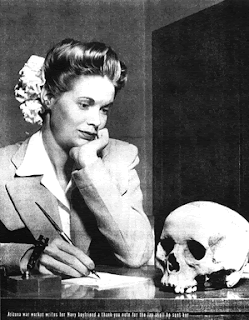
The article mentions how when "Hiroshima: a Soldiers View" was originally published he recieved alot of mail regarding the subject. Most of them were from soldiers and veterans cheering and acknolwedging the trophy skulls, but one marine was objecting to the fact that a common, much envied wartime trophy among the marine corps was a "well washed Japanese Skull".
The vet, stated he was a private in the marine infantry on Tulagi, Guadalcanal, Roi-Namur and Saipan and that he never heard of such barbaric practices.
Fussel explains that there are four possible reasons to how this private could have avoided noticing the common trophies:
- he was remarkably careless in his notice of what was going on.
- he was more intimate with the affairs of they typing pool well then the line of fire
- decently brought up and a nice person, he opted to see no evil.
- his memory, like so many others, was happy to erase all evil memories.
Fussell explains how while visiting a friend it took his host no more than 30 seconds to find a shoe box filled with photos depicting the gruesome trophies.
"one was displayed atop a pole, like a warning at the entrance of a native village"

The method of how these trophies skulls were made is particularly gruesome. First they were boiled in a metal vat, and two marines were busy poking it and turning it with sticks.
Then they removed any extra flesh with lye. After that they attached the skull to a string and dragged it behind them for a few miles to get rid of all the extra flesh.
Lastly, they scrubbed they skulls with Lye strong laundry soap, as to get it squeaky clean.
The skulls, were evidence of how well the respective troops had accomplished their mission, which was to "kill him before he kills you". Regardless, it was believed that this trophy habit, was not half as bad or as brutal as the "ruthless Japs" were. The article states, " why have more respect for the skull of a Jap than the skull of a weasel, a rat, or any other form of mad, soulless vermin?"
This famous picture depicts a skull with the inscription, "Found in New Guinea" that was sent to his girlfriend in Phoenix, AZ. Life Magazine featured this in the magazine.
Return Address:
The Reverend Tsunezo Wachi,
President, Association of Iwo Jima,
2-24-23 Higashicho, Kichijoji,
Musashinoshi, Tokyo, Japan, 180.
The Reverend Tsunezo Wachi,
President, Association of Iwo Jima,
2-24-23 Higashicho, Kichijoji,
Musashinoshi, Tokyo, Japan, 180.




Thank you, it helps me to understand the airtle
ReplyDelete